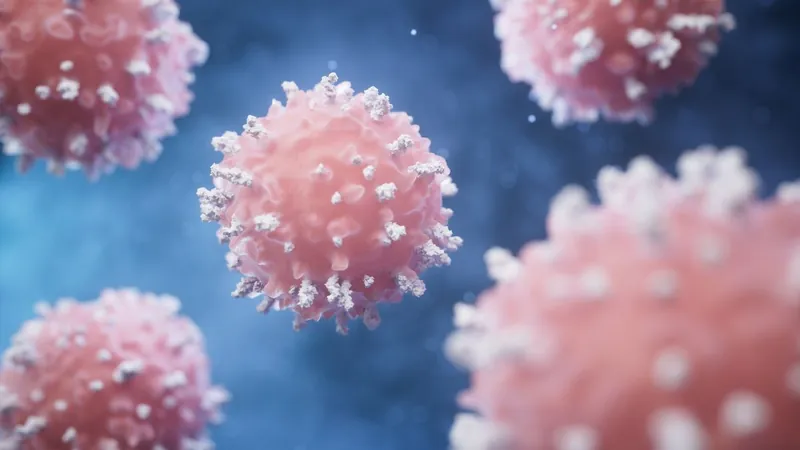
Revolutionary Designer Immune Cells Emerge as a Game-Changer for Transplants and Diabetes Cure!
2024-12-05
Author: Ming
Groundbreaking Development in Transplant Medicine
In a groundbreaking development, scientists have successfully engineered unique immune cells that could prevent the rejection of stem cell transplants, a major hurdle in transplant medicine. This innovative approach holds promise not just for transplant recipients but may eventually lead to a cure for conditions such as type 1 diabetes!
Designer Immune Cells in Action
The new designer immune cells have demonstrated their efficacy in safeguarding insulin-producing cells transplanted into mice, marking a significant step forward in transplant science. Audrey Parent, an associate professor at the University of California, San Francisco (UCSF) Diabetes Center, emphasized the importance of this research, noting that it serves as an early "proof-of-concept" for future applications in humans.
Potential for Revolutionizing Transplant Therapies
If these designer cells prove to be safe and effective in human trials, they could revolutionize how we approach transplant therapies, meaning fewer patients would need to rely on harsh immune-suppressing drugs. Currently, these drugs are necessary to prevent the body's immune response from attacking transplanted tissues, but they come with a host of side effects, including increased risk of infections and toxicity to vital organs like the kidneys.
Addressing Type 1 Diabetes Challenges
In type 1 diabetes, the body's immune system mistakenly targets and destroys pancreatic beta cells essential for insulin production, driven by aggressive immune cells known as killer T cells. While researchers have made strides toward using stem cells to generate new beta cells, a critical challenge remains: protecting these cells from the immune onslaught.
Innovative Solution by Re-engineering T Cells
To tackle this issue, Parent and her team devised a remarkable solution by re-engineering T cells to act as "bodyguards" for the transplanted cells. These designer T cells were specifically programmed to recognize a modified protein—CD19—added to the transplanted beta cells. When the bodyguard T cells bind to CD19, they release a molecule that effectively quells the activity of killer T cells.
Enhancing Protective Capabilities
Additionally, these cells produce a protein that neutralizes inflammatory chemicals, further enhancing their protective capabilities and prompting them to replicate, creating a robust defense mechanism. In experimental trials involving mice, those implanted with beta cells and the designer T cell protectors demonstrated remarkable resilience, maintaining insulin production for over 35 days compared to the rapid failure observed in those without the protective cells.
Identifying Unique Protein Targets
However, challenges remain, particularly in identifying unique protein targets for the designer cells. Most potential targets appear on multiple cell types throughout the body, raising concerns about unintended activation of these protective cells elsewhere, which could complicate the treatment of infections or cancers. To mitigate this risk, the researchers are exploring the possibility of developing artificial targets that would uniquely identify transplanted cells without affecting surrounding healthy tissue.
Broader Implications of the Research
The implications of this research extend beyond diabetes; a parallel study has confirmed that similar designer T cells can effectively target brain tumors without harming adjacent healthy brain cells. These findings could pave the way for novel treatments for a variety of inflammatory and autoimmune diseases, including rheumatoid arthritis, Crohn's disease, and even conditions like multiple sclerosis.
Cautious Optimism from the Scientific Community
With excitement building around this innovative strategy, the scientific community remains cautiously optimistic. While this research heralds a new frontier in targeted therapy for inflammatory diseases, the road to human testing will require several years of rigorous evaluation and development to ensure safety and efficacy.
Conclusion and Future Monitoring
Stay tuned as we monitor these incredible advancements that could ultimately transform the landscape of transplant medicine and autoimmune disease treatment!
 Brasil (PT)
Brasil (PT)
 Canada (EN)
Canada (EN)
 Chile (ES)
Chile (ES)
 Česko (CS)
Česko (CS)
 대한민국 (KO)
대한민국 (KO)
 España (ES)
España (ES)
 France (FR)
France (FR)
 Hong Kong (EN)
Hong Kong (EN)
 Italia (IT)
Italia (IT)
 日本 (JA)
日本 (JA)
 Magyarország (HU)
Magyarország (HU)
 Norge (NO)
Norge (NO)
 Polska (PL)
Polska (PL)
 Schweiz (DE)
Schweiz (DE)
 Singapore (EN)
Singapore (EN)
 Sverige (SV)
Sverige (SV)
 Suomi (FI)
Suomi (FI)
 Türkiye (TR)
Türkiye (TR)
 الإمارات العربية المتحدة (AR)
الإمارات العربية المتحدة (AR)